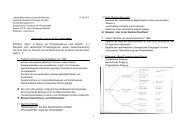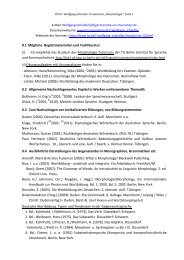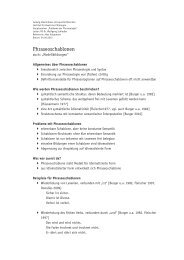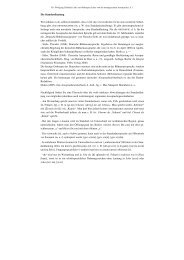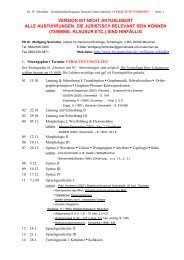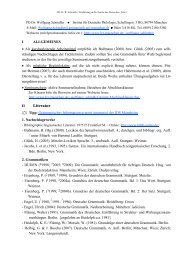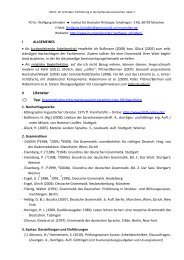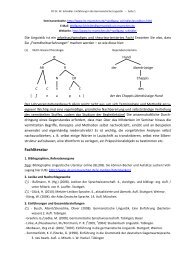Chapter 18 Lexical Functions: Description of Lexical Relations in a ...
Chapter 18 Lexical Functions: Description of Lexical Relations in a ...
Chapter 18 Lexical Functions: Description of Lexical Relations in a ...
You also want an ePaper? Increase the reach of your titles
YUMPU automatically turns print PDFs into web optimized ePapers that Google loves.
—<strong>Chapter</strong> <strong>18</strong>. <strong>Lexical</strong> <strong>Functions</strong>— 66<br />
F <strong>in</strong>dicates the body part or body function affected by (L) as well as the way it is affected (func-<br />
tions with difficulty, stops function<strong>in</strong>g or functions excessively).<br />
Examples<br />
Obstr(speech) —Sympt 23(anger) = [NY] sputters, splutters [with anger]<br />
Obstr(breath) —Sympt 23(anger) = [NY] chokes [with anger]<br />
Stop(speech) —Sympt 2(amazement) = //[NY] is dumbstruck<br />
Excess motor (eyes) —Sympt1(amazement) = //[NY’s] eyes start from their sockets<br />
Excess motor (mouth) —Sympt 213(amazement) = [NY] opens [NY’s] mouth wide [with amazement]<br />
Excess motor (mouth) —Sympt 13(astonishment) = [NY’s] jaw drops [<strong>in</strong> astonishment]<br />
Excess motor (hair) —Sympt 1(fear) = [NY’s] hair stands on end [with fear]<br />
4. Special Phenomena Related to <strong>Lexical</strong> <strong>Functions</strong><br />
Three lexical phenomena related to LFs and their presentation <strong>in</strong> an ECD are relevant to<br />
this presentation: complex LFs, configurations <strong>of</strong> LFs, and fused elements <strong>of</strong><br />
the values <strong>of</strong> LFs.<br />
4.1. Complex <strong>Lexical</strong> <strong>Functions</strong><br />
A complex LF is a comb<strong>in</strong>ation <strong>of</strong> syntactically related LFs that has a s<strong>in</strong>gle expression<br />
cover<strong>in</strong>g the mean<strong>in</strong>g <strong>of</strong> the comb<strong>in</strong>ation as a whole. A complex LF is written as a sequence <strong>of</strong><br />
simple standard LFs, e.g., fg or fgh, etc. In po<strong>in</strong>t <strong>of</strong> fact, such sequences encode particular<br />
DSynt-relations between constituent LFs; the correspond<strong>in</strong>g relation is specified for each simple<br />
LF (see the list <strong>in</strong> 2.2). Thus, generally speak<strong>in</strong>g, fg(L) = L´ means<br />
• either f(L)–r 1 →g(L) = L´, such that (f(L)−r 1 →g(L)) = (L´),<br />
• or f(L)←r 2 –g(L) = L´, such that (f(L)←r 2 −g(L)) = (L´);<br />
which is the case is <strong>in</strong>dicated <strong>in</strong> the description <strong>of</strong> f and/or g.<br />
More precisely, the <strong>in</strong>ternal syntax <strong>of</strong> a complex LF—except for Anti, Conv and structural<br />
derivations (S i, A i and Adv i) as left members <strong>of</strong> complex LFs—is specified by straightforward<br />
rules valid for each simple LF (F stands for any LF):<br />
MagnF = Magn←ATTR−F; IncepF = Incep−II→F; CausF = Caus−II→F; etc.<br />
However, Anti, Conv, Si, Ai and Advi are used with<strong>in</strong> complex LFs as derivational affixes; thus<br />
S i, A i and Adv i, added on the left <strong>of</strong> an LF-formula, convert it <strong>in</strong>to an N, an A or an Adv,


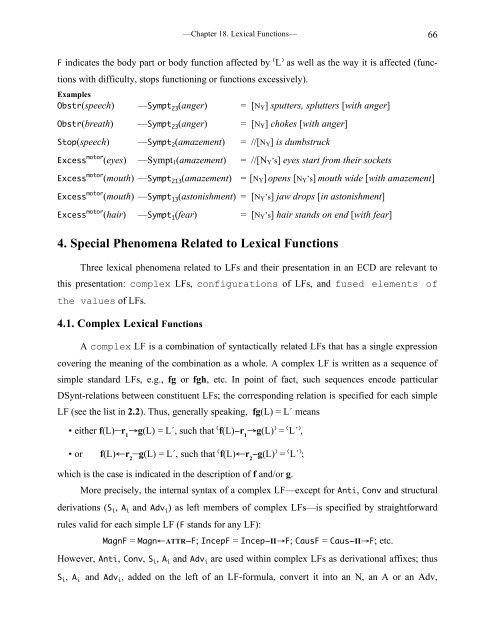
![E-Mail: Wolfgang.Schindler[ätt]germanistik.uni-muenchen.de Web ...](https://img.yumpu.com/51590147/1/184x260/e-mail-wolfgangschindlerattgermanistikuni-muenchende-web-.jpg?quality=85)
